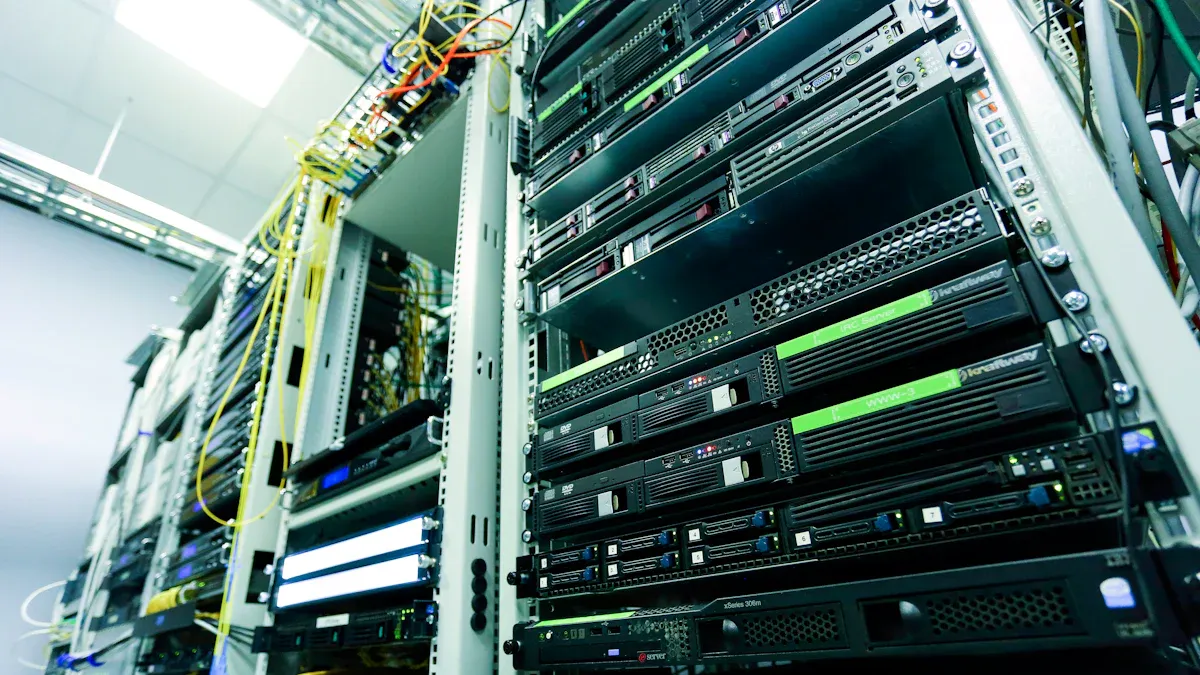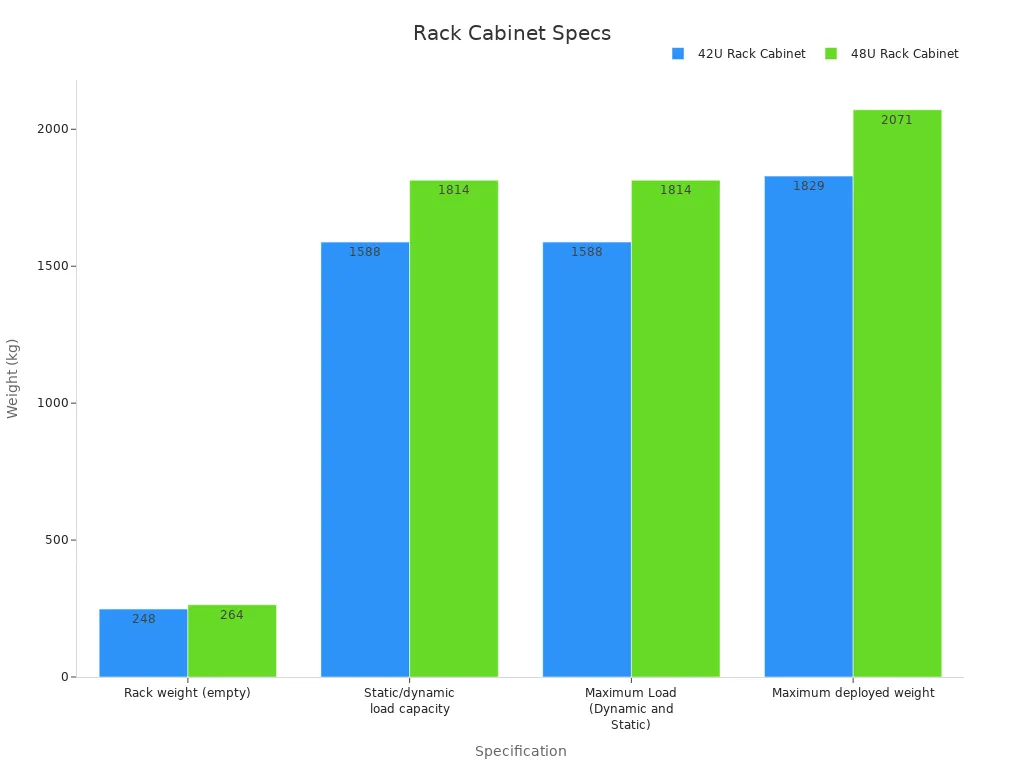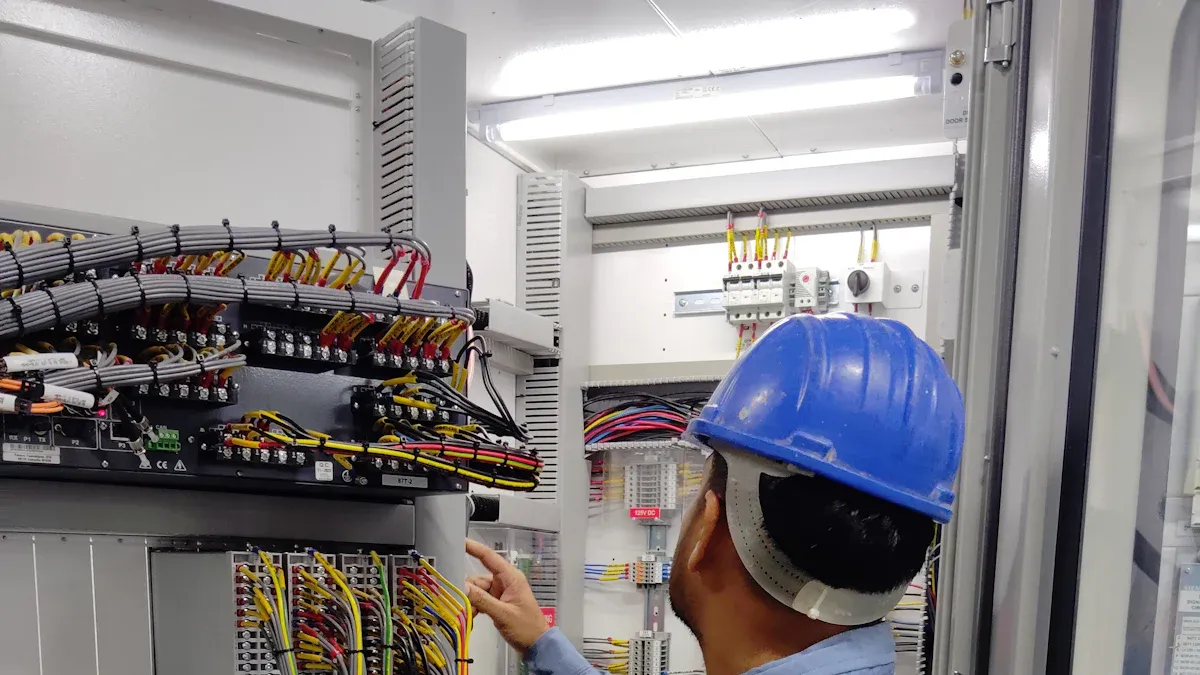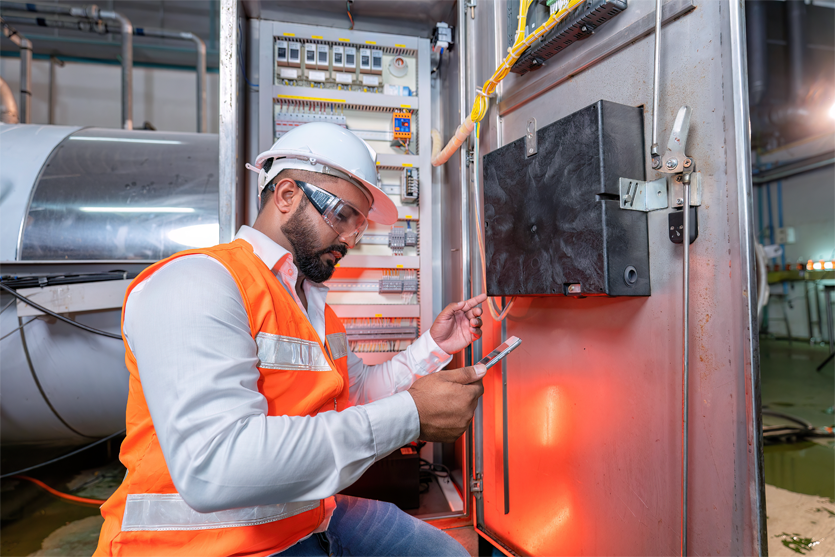How to Select the Right ESTEL Data Rack Cabinet for Your Needs

Selecting the right data rack cabinet directly impacts how well your server performs and how long it lasts. Proper airflow management ensures cool air reaches your equipment while hot air exits efficiently, preventing overheating. Features like perforated doors, adjustable mounting rails, and blanking panels improve air circulation and reduce hot spots. Organized cable management optimizes cooling and minimizes clutter. ESTEL’s innovative designs include integrated cooling systems tailored for high-density setups, making them ideal for protecting your server and maximizing efficiency.
Key Takeaways
Picking the right data rack cabinet is very important. It helps your servers work well and last longer.
Check the rack's weight limit and material strength. A strong cabinet keeps your equipment safe and secure.
Make sure it fits your server equipment. The rack's size should match your hardware to avoid problems.
Focus on good cooling. Choose racks with great airflow to keep things cool and stop overheating.
Keep cables neat and tidy. Use cable trays and guides to avoid mess and make maintenance easier.
Basics of Data Rack Cabinets
What Is a Data Rack Cabinet?
A data rack cabinet is a specialized enclosure designed to house and organize IT equipment such as servers, routers, and switches. These cabinets play a vital role in maintaining order and protecting your hardware in a data center. They are standardized according to the Electronic Industries Alliance (EIA-310-D), ensuring compatibility with most equipment. Typically, their height is measured in rack units (U), while width and depth are specified in millimeters. You can find cabinets in various sizes and shapes, making them adaptable to different setups.
Tip: When selecting a rack cabinet, always check its dimensions and ensure it meets your equipment's requirements.
Types of Rack Cabinets
Rack cabinets come in several types, each catering to specific needs. Here’s a breakdown:
Rack Cabinet Type | Description |
|---|---|
<10U | Compact and cost-effective, ideal for small offices or home networks. |
11~20U | Versatile for small to medium data centers, offering adjustable features. |
21~30U | Suitable for medium-sized data centers, with enhanced cooling and security. |
31~40U | Designed for large data centers, supporting high-density layouts. |
41~50U | High-capacity cabinets optimized for massive data centers. |
Wall-mount cabinets are also gaining popularity among small and medium enterprises (SMEs) due to space constraints. Modular designs and intelligent cooling systems are shaping the market, making these cabinets more efficient and adaptable.
Applications of Server Racks
Server racks are indispensable in modern data centers. They are widely used across industries such as IT, telecommunications, healthcare, and retail. These racks help you optimize data center efficiency by organizing equipment and improving airflow. The global data center rack market is projected to grow at a compound annual growth rate (CAGR) of 14.40% from 2024 to 2032, driven by the adoption of high-density servers and advanced cooling technologies. Key sectors like BFSI, government, and manufacturing rely heavily on server racks for secure data management and compliance.
Note: The IT and telecom sector alone is expected to account for 32% of the market share in 2024, highlighting the critical role of server racks in this industry.
Key Factors in Selecting a Rack Cabinet
Size and Space Considerations
Choosing the right rack size is one of the most important steps in optimizing your data center. The size of your rack cabinet directly affects how well it accommodates your server equipment and how efficiently it uses available space. You need to evaluate the dimensions of your critical IT equipment and ensure the rack provides enough room for current and future needs.
Server rack sizes are typically measured in rack units (U), where 1U equals 1.75 inches in height. The standard size for server cabinets is 42U, but other common server rack sizes include 24U, 48U, and 52U. When selecting a rack, consider both the height and depth. For example, deeper racks are better suited for high-density servers, while smaller racks work well in compact spaces.
Tip: Always leave extra space in your rack enclosure for airflow and potential equipment upgrades. This ensures operational efficiency and prevents overcrowding.
Rack size matters not only for fitting your equipment but also for maintaining proper cooling and cable management. A poorly chosen rack size can lead to overheating and clutter, reducing the overall quality of your setup. To choose the right rack size, measure your equipment carefully and account for any additional accessories like power distribution units (PDUs) or cooling systems.
Weight Capacity and Material Durability
The weight capacity and build quality of your rack cabinet are critical for ensuring the safety and longevity of your server equipment. A high-quality rack must support the weight of your servers and other hardware without compromising its structural integrity.
Different racks have varying weight capacities, which are categorized into static and dynamic loads. Static load refers to the weight the rack can hold when stationary, while dynamic load applies when the rack is being moved. For example, a 42U rack cabinet can handle a static load of 1588 kg (3500 lb), while a 48U rack cabinet supports up to 1814 kg (4000 lb).
Description | 42U Rack Cabinet | 48U Rack Cabinet |
|---|---|---|
Rack weight (empty) | 248 kg (547 lb) | 264 kg (582 lb) |
Static/dynamic load capacity | 1588 kg (3500 lb) | 1814 kg (4000 lb) |
Maximum deployed weight | 1829 kg (4032 lb) | 2071 kg (4566 lb) |
The material used in the rack also plays a significant role in its durability. High-quality racks are typically made from steel or aluminum, which provide excellent strength and resistance to wear and tear. Investing in a durable rack ensures your critical IT equipment remains secure, even in demanding environments.

Note: Always verify the weight capacity of your rack before installation to avoid overloading, which can compromise safety and operational efficiency.
Compatibility with Server Equipment
Ensuring compatibility between your rack and server equipment is essential for a seamless setup. Not all racks are designed to fit every type of server, so you need to confirm that your chosen rack size matches the dimensions and mounting requirements of your hardware.
Most racks follow the EIA-310-D standard, which ensures compatibility with a wide range of server equipment. However, you should still double-check the depth, width, and height of your servers against the rack’s specifications. For example, if you’re using high-density servers, you may need a deeper rack to accommodate them comfortably.
Cable management is another factor to consider when evaluating compatibility. A well-designed rack should include features like cable trays, grommets, and tie points to keep cables organized and out of the way. This not only improves operational efficiency but also reduces the risk of damage to your equipment.
Pro Tip: When planning your setup, think about future expansion. Choose a rack that offers enough flexibility to accommodate additional servers or accessories as your needs grow.
Cooling Efficiency and Airflow Management

Importance of Cooling for Server Performance
Cooling plays a critical role in maintaining the performance and longevity of your server. Servers generate significant heat during operation, and without proper cooling, this heat can lead to overheating, hardware failure, and reduced efficiency. Effective cooling ensures that your equipment operates within safe temperature ranges, preventing costly downtime and extending the lifespan of your hardware.
Proper airflow management is essential for achieving optimal cooling efficiency. By directing cool air to your servers and expelling hot air, you can maintain a stable environment within your rack enclosure. Poor airflow can create hot spots, which increase the risk of overheating. To avoid this, you should prioritize racks with advanced ventilation features and design your setup to promote efficient airflow.
Tip: Regularly monitor the temperature inside your data rack cabinet to ensure your cooling system is functioning effectively.
Ventilation Features in ESTEL Rack Cabinets
ESTEL rack cabinets are designed with advanced ventilation features to meet the cooling needs of modern data centers. These features enhance airflow management, ensuring your servers remain cool even in high-density setups. Some of the key ventilation features include:
Perforated Doors: These doors allow air to flow freely through the rack, improving cooling efficiency. They are especially useful in environments with active cooling systems.
Adjustable Mounting Rails: These rails help you position your equipment to optimize airflow. Proper spacing between servers ensures that cool air reaches all components.
Cable Management Systems: Organized cables reduce airflow obstructions, allowing your cooling system to work more effectively.
Blanking Panels: These panels fill empty spaces in your rack, preventing air recirculation and directing cool air to where it is needed most.
By incorporating these features, ESTEL cabinets provide a reliable solution for maintaining optimal temperatures in your data center. Their innovative designs cater to a wide range of server rack sizes, making them suitable for various setups.
Note: When selecting a rack cabinet, consider the ventilation features that best align with your cooling requirements.
Comparing Active and Passive Cooling Options
Choosing between active and passive cooling depends on your specific needs and the environment of your data center. Both methods have their advantages and limitations, which you should evaluate carefully.
Feature | Active Cooling | Passive Cooling |
|---|---|---|
Method | Uses air conditioning systems for temperature control | Relies on natural airflow |
Efficiency | High efficiency for high-density setups | Cost-effective but less effective in high-density |
Maintenance | Higher installation and maintenance costs | Simple and inexpensive to maintain |
Environmental Suitability | Ideal for rugged environments and data centers | Best for low-density racks in controlled settings |
Energy Consumption | Requires significant power | Saves energy but may struggle in harsh conditions |
Active cooling systems, such as air conditioners and fans, are ideal for high-density setups. They handle higher heat loads and maintain consistent temperatures, but they consume more energy and require regular maintenance. Passive cooling, on the other hand, relies on natural airflow through conduction, convection, and radiation. It is energy-efficient and cost-effective but may not perform well in high-density environments.
Active Cooling: This method uses fans, pumps, or compressors to regulate temperature. It is highly effective for managing heat in large data centers but comes with higher operational costs.
Passive Cooling: This approach depends on natural airflow and is suitable for low-density racks. While it saves energy, it may struggle to maintain optimal temperatures in demanding conditions.
When deciding between these options, consider the size of your data center, the density of your servers, and your budget. Active cooling is better for larger setups, while passive cooling works well for smaller, controlled environments.
Pro Tip: Combine active and passive cooling methods for a hybrid solution that balances efficiency and cost-effectiveness.
Cable Management in Server Racks

Benefits of Organized Cable Management
Organized cable management offers numerous advantages for your server setup. It ensures optimal performance by reducing hardware failure risks and minimizing downtime. Properly arranged cables simplify maintenance, making it easier to identify and resolve issues quickly. This approach also supports scalability, allowing you to upgrade or reconfigure your infrastructure without unnecessary complications.
A well-managed cable system enhances safety by reducing tripping hazards and preventing cable fraying. It also extends the lifespan of your equipment by avoiding overstressed cables. Additionally, organized cables improve system reliability, ensuring smoother operations and easier troubleshooting. By maintaining a neat setup, you can save money on replacements and enhance workplace aesthetics.
Tip: Use cable trays, grommets, and tie points to keep cables secure and prevent tangling.
Cable Management Features in ESTEL Cabinets
ESTEL cabinets include advanced cable management features designed to optimize your server setup. These features prevent tangling and damage, simplifying maintenance and improving overall functionality. For example, cable guides or sleeves help route cables safely, reducing wear and tear. Tie-downs and slack storage secure cables in place, preventing movement that could lead to tangling or damage.
Feature | Benefit |
|---|---|
Efficient cable management | Prevents tangling and damage, enhancing functionality and maintenance. |
Cable guides or sleeves | Safely route cables, reducing wear and tear. |
Tie-downs and slack storage | Secure cables, preventing movement and potential damage. |
Organized cables | Enhance appearance and reduce operational inefficiencies. |
These features not only improve the appearance of your rack cabinet but also reduce the risk of operational inefficiencies. By investing in ESTEL cabinets, you can ensure a professional and tidy setup that supports your data center's long-term success.
Tips for Maintaining a Clutter-Free Setup
Maintaining a clutter-free server rack requires consistent effort and strategic planning. Start by labeling all cables to make identification easier during maintenance. Use color-coded cables to differentiate between various connections. Install cable trays and routing panels to keep cables organized and out of the way.
Lockable network rack cabinets can also help secure equipment and improve airflow. For example, an e-commerce company resolved overcrowding issues by replacing older racks with modern ones featuring efficient cable management systems. This change reduced clutter, improved airflow, and made maintenance easier for technicians.
Pro Tip: Regularly inspect your cables for wear and tear. Replace damaged cables promptly to avoid disruptions.
By following these tips, you can create a clean and efficient server environment that supports optimal performance and scalability.
Security and Accessibility in Rack Cabinets
Locking Systems and Access Control
Protecting your server equipment from unauthorized access is crucial for maintaining data integrity and operational efficiency. A rack cabinet with robust locking systems and access control features can prevent physical tampering, theft, and vandalism. These security features safeguard your hardware and sensitive information, ensuring uninterrupted operations in your data center.
Risk Type | Description |
|---|---|
Unauthorized Access | Anyone can tamper with critical hardware, leading to stolen or damaged equipment and data leaks. |
Theft of Data Storage Devices | Physical access to servers makes hard drives vulnerable to theft, risking sensitive information. |
Vandalism and Sabotage | Malicious tampering can cause long-term downtime and equipment failure, crippling operations. |
Environmental Risks | Unlocked cabinets may be accessed accidentally, leading to unintentional damage to sensitive equipment. |
Modern rack cabinets often include biometric locks, keypads, or RFID systems to enhance security. These features ensure that only authorized personnel can access the server rack, reducing the risk of breaches.
Tip: Regularly update access credentials and monitor access logs to maintain a secure environment.
Environmental Protection Features
Environmental factors can significantly impact the performance and lifespan of your server equipment. Advanced environmental protection features in rack cabinets help mitigate these risks. These cabinets are designed to withstand harsh conditions, such as dust and water ingress, ensuring your servers remain safe and operational.
Feature | Description |
|---|---|
Advanced Environmental Protection | Designed to withstand harsh weather, including dust and water ingress. |
Temperature Regulation | Equipped with fan modules and thermostatic controls for consistent management. |
Enhanced Security | Features lockable doors and tamper-proof mechanisms for data protection. |
Versatile Installation Options | Adaptable for various setups, including wall mount and floor standing. |
Temperature regulation is another critical feature. Fan modules and thermostatic controls maintain consistent temperatures, preventing overheating. These features make rack cabinets suitable for diverse environments, from small offices to large data centers.
Note: Choose a rack cabinet with environmental protection features that match your specific setup and location.
Maintenance Accessibility
Efficient maintenance is essential for minimizing downtime and ensuring smooth server operations. Rack cabinets with accessible designs simplify routine checks and repairs. Features like removable side panels, adjustable mounting rails, and cable management systems make it easier to access and service your equipment.
Accessible designs also reduce the time required for troubleshooting, allowing you to address issues quickly. For example, a well-organized server rack with labeled cables and clear pathways can save hours during maintenance. This not only improves efficiency but also reduces the risk of accidental damage.
Pro Tip: Schedule regular maintenance checks to identify and resolve potential issues before they escalate.
Customization and Scalability of Server Racks
Modular Design for Future Expansion
A modular design allows you to expand your server infrastructure as your needs grow. This approach ensures that your rack cabinet can adapt to increasing workloads without requiring a complete overhaul. Modular data centers, for instance, enable faster deployment and scalability. These features are essential for meeting the computational demands of modern technologies like AI and machine learning. Prefabricated components also reduce construction timelines, transforming projects that once took years into months.
Major data center providers are adopting modular designs to enhance flexibility. This trend supports edge and remote deployments, making it easier to scale operations in diverse environments. By choosing a modular rack, you can future-proof your setup and ensure it remains viable as your business evolves.
Tip: Opt for a modular rack cabinet if you anticipate rapid growth or fluctuating server requirements.
Customizable Features in ESTEL Cabinets
ESTEL offers customizable rack solutions tailored to meet your specific needs. These cabinets include adjustable mounting rails, removable panels, and integrated cable management systems. Such features allow you to configure your rack to accommodate various server types and accessories. For example, you can adjust the depth of the rack to fit high-density servers or add blanking panels to improve airflow.
Customizable racks also support energy-efficient designs. Innovations in smart rack technologies, such as integrated cooling systems, enhance performance while reducing energy consumption. These features make ESTEL cabinets ideal for businesses seeking scalable infrastructure that aligns with sustainability goals.
Pro Tip: Evaluate your current and future server requirements to select the most suitable customizable features.
Planning for Future Server Needs
Planning for future server needs involves anticipating changes in technology and workload demands. The growing reliance on cloud services and data centers highlights the importance of scalable infrastructure. High-density server racks are becoming increasingly popular as companies establish more data centers to support digital transformation.
Source | Evidence |
|---|---|
North America Server Rack Market Growth | Increased reliance on data centers and cloud services drives market growth. |
High-Density Racks Market Growth | Demand for scalable and energy-efficient infrastructure is rising. |
Server Chassis Market Growth | Modular and customizable chassis enable efficient scaling. |
To prepare for future growth, consider racks that offer flexibility and scalability. Features like adjustable rails and modular designs ensure your setup can adapt to new technologies. This proactive approach minimizes disruptions and maximizes the lifespan of your infrastructure.
Note: Regularly assess your data center's capacity to ensure it aligns with your long-term goals.
Choosing the right data rack cabinet is essential for maintaining server performance and ensuring long-term reliability. A well-suited rack cabinet optimizes cooling, enhances security, and supports scalability, making it a critical component of any data center. ESTEL’s innovative designs address these needs with features like advanced airflow management and modular configurations. These solutions help you create a future-proof setup tailored to your requirements.
Explore ESTEL’s product range today to find the perfect server rack for your data center. Their customizable options ensure your infrastructure remains efficient and adaptable as your needs evolve.
FAQ
1. How do I determine the right size for my data rack cabinet?
Measure your server equipment's dimensions, including height, width, and depth. Add extra space for airflow and future upgrades. Standard sizes like 42U work for most setups, but smaller or larger options may suit specific needs. Always plan for scalability.
Tip: Use a rack size calculator to simplify your decision-making process.
2. What cooling system should I choose for my server rack?
Choose active cooling for high-density setups requiring precise temperature control. Passive cooling works well for low-density environments with natural airflow. A hybrid approach combines both methods, balancing efficiency and cost.
Pro Tip: Monitor your rack's temperature regularly to ensure your cooling system performs effectively.
3. Are ESTEL cabinets compatible with all server types?
Yes, ESTEL cabinets follow the EIA-310-D standard, ensuring compatibility with most server equipment. Check your server's dimensions and mounting requirements to confirm a proper fit. Adjustable mounting rails in ESTEL cabinets enhance flexibility.
Note: Always verify compatibility before purchasing to avoid installation issues.
4. How can I improve cable management in my rack cabinet?
Label all cables and use color-coded wires for easy identification. Install cable trays, grommets, and tie points to keep cables organized. Regularly inspect and replace damaged cables to maintain a clutter-free setup.
Tip: Invest in ESTEL cabinets with built-in cable management features for a professional look.
5. What security features should I look for in a rack cabinet?
Look for cabinets with locking systems like biometric locks, keypads, or RFID access. These features prevent unauthorized access and protect sensitive data. Environmental protection features, such as dust and water resistance, also enhance security.
Pro Tip: Update access credentials frequently to maintain a secure environment.
See Also
Selecting The Ideal Cooling Solution For ESTEL Telecom Cabinets
Finding The Perfect Outdoor Electrical Cabinet For Your Requirements
Understanding The Safety Features Of Custom ESTEL Telecom Cabinets
Simplifying The Selection Of Rackmount Enclosure Depth Options
Exploring ESTEL Cabinet Cooling Options For Industrial Use Cases
CALL US DIRECTLY
86-13752765943
3A-8, SHUIWAN 1979 SQUARE (PHASE II), NO.111, TAIZI ROAD,SHUIWAN COMMUNITY, ZHAOSHANG STREET, NANSHAN DISTRICT, SHENZHEN, GUANGDONG, CHINA


